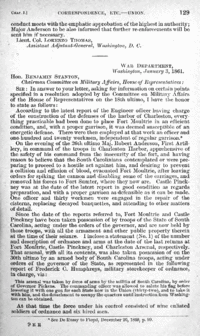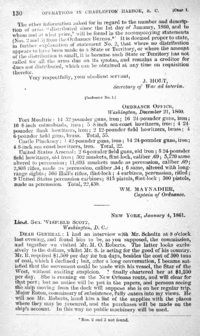 Click for full-sized scanned image  Click for full-sized scanned image Union Correspondence, etc.
WAR DEPARTMENT,
Washington, January 3, 1861
Honorable BENJAMIN STANTON,
Chairman Committee on Military Affairs, House of Representatives:
SIR: In answer to your letter, asking for information on certain points specified in a resolution adopted by the Committee on Military Affairs of the House of Representatives on the 18th ultimo, I have the honor to state as follows:
According to the latest report of the Engineer officer having charge of the construction of the defenses of the harbor of Charleston, everything practicable had been done of place Fort Moultrie in an efficient condition, and, with a proper garrison, it was deemed susceptible of an energetic defense. There were then employed at that work an officer and one hundred and twenty workmen, independent of regular garrison.[1]
On the evening of the 26th ultimo Major Robert Anderson, First Artillery in command of the troops in Charleston Harbor, apprehensive of the safety of his command from the insecurity of the fort, and having reason to believe that the South Carolinians contemplated or were preparing to proceed to a hostile act against him, and desiring to prevent a collision and effusion of blood, evacuated Fort Moultrie after having orders for spiking the cannon and disabling some of the carriages, and removed his forces to Fort Sumter, where they now are. Castle Pinckney was at the date of the latest report in good condition as regards preparation and with a proper garrison as defensible as it can be made. One officer and thirty workmen were engaged in the repair of the cisterns, replacing decayed baguettes, and attending to other matters of detail.
Since the date of the reports referred to, Fort Moultrie and Castle Pinckney have been taken possession of by troops of the State of South Carolina, acting under the orders of the governor, and are now held by those troops, with all the armament and other public property therein at the time of their seizure. I inclose a statement (Numbers 1.) of the number and description of ordnance, and arms at the date of the last returns at Fort Moultrie, Castle Pinckney, and Charleston Arsenal, respectively. That arsenal, with all its contents, was also taken possession of on the 30th ultimo by an armed by body of South Carolina troops, acting under orders of the governor of the State, as represented in the following report of Frederick C. Humphreys, military storekeeper of ordnance, in charge, viz:
This arsenal was taken by force of arms by the militia of South Carolina, by order of Governor Pickens. The commanding officer was allowed to salute his flag before lowering it with one gun for each State now in the Union (thirty-two), and to take it with him, and the detachment to occupy the quarters until instruction from Washington can be obtained.
At that time the force under his control consisted of nine enlisted soldiers of ordnance and six hired men.
The other information asked for in regard to the number and description of arms "distributed since the 1st day of January, 1860, and to whom and at what price," will be found in the accompanying statements (Nos. 2 and 3) from the Ordnance Bureau.[2] It is deemed proper to state, in further explanation of statement Numbers 2, that where no distribution appears to have been made to a State or Territory, or where the amount of the distribution is small, it is because such State or Territory has not called for all the arms due on its quotas, and remains a creditor for dues not distributed, which can be obtained at any time on requisition therefor.
Very respectfully, your obedient servant,
J. HOLT,
Secretary of War ad interim.
[Inclosure No. 1.]
| December 21, 1860 - Inventory by Captain William Maynadier
|
 Click for full-sized scanned image Union Correspondence, etc.
ORDNANCE OFFICE,
Washington, December 21, 1860.
Fort Moultrie; 14 32-pounder guns, iron; 16 24-pounder guns, iron; 10, 8-inch columbiads, iron; 5 8-inch sea-coast howitzers, iron; 4 24-pounder flank howitzers, iron; 2 12-pounder field howitzers, brass; 4 6-pounder field guns, brass. Total, 55.
Castle Pinckney: 4 42-pounder guns, iron; 14 24-pounder guns, iron; 4 8-inch sea-coast howitzers, iron. Total, 22.
United States Arsenal: 2 6-pounder field guns, old iron ; 5 24-pounder field howitzers, old iron; 502 muskets, flint-lock, caliber .69; 5,720 same altered to percussion; 11,693 muskets made as percussion, caliber .69; 2,808 rifles, made as percussion, caliber .54; 6 same, altered with longrange sights; 566 Hall's rifles, flint-lock; 4 carbines, percussion, rifled; 9 United States percussion carbines; 815 pistols, flint-lock; 300 pistols, made as percussion. Total, 22,430.
WM. MAYNADIER,
Captain of Ordnance.
(To view this page in its Source Category, click HERE)
|
(To view this page in its Source Category, click HERE for Part 1 and HERE for Part 2)
|